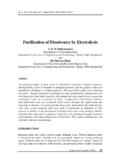Transcription of Traditional and Household Water Purification …
1 UNESCO EOLSSSAMPLE CHAPTERSWASTEWATER RECYCLE, REUSE, AND RECLAMATION Vol. II - Traditional and Household Water Purification methods of Rural Communities in Developing Countries - S. Vigneswaran, M. Sundaravadivel Encyclopedia of Life Support Systems (EOLSS) Traditional AND Household Water Purification methods OF RURAL COMMUNITIES IN DEVELOPING COUNTRIES S. Vigneswaran Faculty of Engineering, University of Technology, Sydney, Australia M. Sundaravadivel Graduate School of the Environment, Macquarie University, Sydney, Australia Keywords: Defluoridation, Filtration, Traditional treatment, Water quality, Water treatment Contents 1.
2 Introduction 2. Traditional Water Treatment methods Filtration through Winnowing Sieve Filtration through Cloth Filtration through Clay Vessels Clarification and Filtration using Plant Parts Jempeng Stone Filter Method 3. Appropriate Water Treatment methods Horizontal Flow Coarse Media Filter Upflow Gravel Filter Two-stage Filter Upflow-downflow Filter 4. Household Water Treatment methods Filtration and Siphoning Technique Coagulation and Sand Filtration Unit Water Filter Canister Household Slow Sand Filtration Unit Indian Design Thailand Design Household Defluoridator Glossary Bibliography Biographical Sketches Summary A safe and convenient Water supply plays a vital role in public health and well-being of the society.
3 While there are numerous conventional Water treatment technologies available, for a huge population in rural areas of developing countries, these systems would be inappropriate or too expensive. All over the world, these rural communities have adopted some simple and rudimentary Water treatment techniques that can serve either a community or individual households. Basically, all such techniques aim to remove visible impurities such as leaves, twigs, or large suspended particles from Water UNESCO EOLSSSAMPLE CHAPTERSWASTEWATER RECYCLE, REUSE, AND RECLAMATION Vol.
4 II - Traditional and Household Water Purification methods of Rural Communities in Developing Countries - S. Vigneswaran, M. Sundaravadivel Encyclopedia of Life Support Systems (EOLSS) collected from unprotected local sources. These Traditional Water treatment techniques range from simple filtration using a sieve or cloth to clarification and filtration using naturally available stone filters and plant materials. Attempts have also been made to develop simple treatment techniques that can serve households of isolated communities either at Household level or at community level.
5 Coarse media filters, gravel filters, coconut fiber filters, etc., are examples of such developments. There are also Household techniques available to remove even some specific Water pollutants such as fluorides that can greatly enhance the safety of usage of Water for drinking purposes in Water -scarce regions where there is no other appropriate Water source. 1. Introduction A safe and convenient Water supply is of paramount importance to human health and the well-being of any society. There exist numerous high technology systems to purify Water . But for a huge proportion of population in the developing world that lives in the rural areas, such systems would be inappropriate or too expensive.
6 These rural populations of developing countries adopt some techniques with a low level of mechanization to suit their own situation. The special features involved in such Traditional treatment methods are worth considering for dissemination, before general technological solutions based on wider experience are proposed for these communities. The Traditional Water treatment techniques can be found either serving a small rural community as a whole or individual households. This article collates some of these Traditional and Household techniques that are widely used in rural areas of developing countries and also some of the Water treatment techniques that have been developed, especially to cater for households of these communities.
7 2. Traditional Water Treatment methods All over the world, rural communities have adopted simple and rudimentary treatment techniques that mainly aim at filtering out the visible impurities from the Water collected from local sources. Though these Traditional methods are expedient and can remove certain types of particles in Water , they do not provide Water necessarily of what would be considered, under the present day situation, as drinking quality. However, it can be considered that these methods provide Water of quality that is acceptable to these rural communities, and in most of the cases, with a further simple step of disinfection, they could yield Water free from pathogens.
8 Some of the Traditional treatment methods are: 1. Filtration through winnowing sieve (used widely in Mali). 2. Filtration through cloth (commonly used in villages in India, Mali and the southern part of Niger). 3. Filtration through clay vessels (used in Egypt). 4. Clarification and filtration through plant material (commonly used in Tamil Nadu and Kerala, India). 5. Jempeng stone filter method (used in Bali, Indonesia). UNESCO EOLSSSAMPLE CHAPTERSWASTEWATER RECYCLE, REUSE, AND RECLAMATION Vol. II - Traditional and Household Water Purification methods of Rural Communities in Developing Countries - S.
9 Vigneswaran, M. Sundaravadivel Encyclopedia of Life Support Systems (EOLSS) Filtration through Winnowing Sieve This type of filtration is used when the Water source is polluted by wind-borne impurities such as dry leaves, stalks, and coarse particles. The raw Water is passed through a winnowing sieve, and the impurities are filtered. This type of filter is widely used in villages of the Bamaka area, Mali. This method cannot be used when the raw Water is highly turbid or muddy, since the sieve cannot filter fine suspended particles in raw Water . Filtration through Cloth Thin white cotton cloth or a discarded garment is used as the filter medium.
10 This filter can filter raw Water containing such impurities as plant debris, insects, dust particles or coarse mud particles. Filtration of suspended particles present in Water can be achieved only to a very small extent. Therefore, this type of filtration is not suitable for highly turbid Water . It is most suitable for filtration of well Water . This practice of cloth filtration is quite common in villages in India, Mali, the southern part of Niger and probably in many other parts of the developing world. In some of the Indian villages, if the raw Water is muddy and highly odorous, then wood ash of Sal tree (Shora robuta) is mixed with Water and then filtered through cloth.















